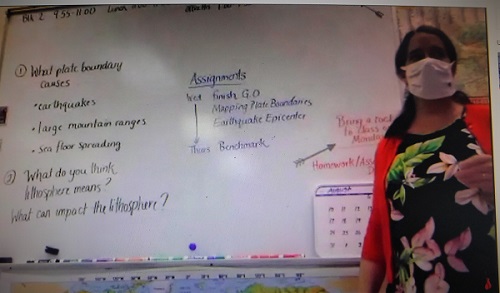
BY KARISSA MILLER
The sudden closure of public schools to in-person learning last spring forced Iredell-Statesville Schools’ teachers to transition to online instruction during the COVID-19 pandemic.
I-SS Executive Director of Secondary Education Kelly Cooper said COVID-19 style teaching is similar to being a first-year teacher.
“Your first year of teaching is the hardest year you’ll teach. You spend a lot of time finding resources because everything is brand new,” Cooper said. “Every teacher we have in this district is a first-year teacher. It’s been very, very difficult and very hard. They have put a lot of work into it.”
This year, I-SS has offered a variety of options for families, including remote, hybrid (live synchronous online and in-person teaching) and in-person learning.
For Alexandra Shadroui, a science teacher at Agriculture and Science Early College, the switch from a lab-based curriculum to a hybrid classroom was very challenging.
“It was difficult for me to process what that would look like in a classroom. (In a classroom) where we are all moving, we are all collaborating and learning hands-on,” Shadroui said. “I have this poster in my classroom that’s an Apollo 13 poster that says, ‘Is this a crisis or an opportunity?’ ”
It took me a few days to process it, she recalled, but she was determined to make this new experience an opportunity.
Shadroui, along with other teachers, has had to learn online learning tools and techniques while also passing this additional information along to their students.
With platforms like Zoom, Shadroui can still have students collaborate and discuss their lesson without being in the classroom. She also picks up her laptop and moves it for the online students to see lab demonstrations and other activities.
“We want our students to have the same education rigor and standard as much as possible … we keep holding expectations,” Shadroui explained.
Planning and collaboration with other teachers at her school has been key, she said.
Shadroui also polled her students on engagement. She said that 95 percent of her students ranked her classroom a four out of five for engagement for the learning environment.
“It’s really a mindset shift. When we shift our minds, we can do great things,” Shadroui said.
Lauren Welch, a third-year social studies teacher at ASEC, is also teaching in a hybrid classroom environment. Welch said that her students are practicing discourse using the Socratic method. She said that students must give each other space to talk and listen in a civil way.
“Students are graded on the quality of their discussion, contextual analysis, are they being respectful, are they being inviting — we are really work on this feeling of community in my classroom although not all of my students are not in the classroom — some are at home,” Welch said.
ASEC Principal Billy Wells said Wednesdays have been critical for his staff since teachers are doing more this school year.
“The energy level in the classroom is amazingly good. I’m so impressed with the teachers,” he said.
In the future, Wells said, ASEC staff will take time to look at the things that have been very positive in the first semester.
He mentioned that some students who would have never been engaged are now speaking up in a class of six to 10 students, rather than if it were a class of 25 students.
“I don’t want to lose sight of some of the lessons we have learned. We will look at how to make it even better next semester,” Wells said.
Cooper agreed.
“There have been some silver linings and blessings we have learned from COVID,” she said.
Cooper said that the district’s ability to share what is working is one way that they can improve the way teachers engage their students.
From the smallest to the biggest problems, the district is continuing to navigate through synchronous learning and other issues, and working towards solutions.



